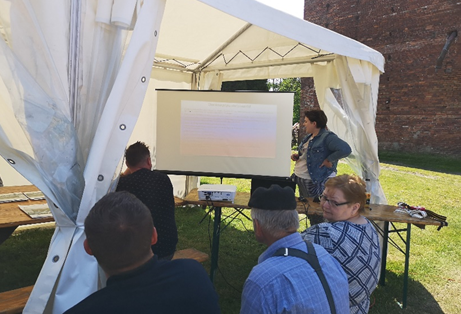A visit by livestock farmers from the Opolskie Voivodeship to a demonstration farm in Kujakowice Górne as part of sub-measure 1.2. “Support for demonstration projects and information activities” implemented under the Rural Development Programme 2014–2020 for “Modern technologies for breeding and raising beef cattle”.
The demonstration series is implemented under sub-measure 1.2 “Support for demonstration projects and information activities” of the Rural Development Programme 2014–2020 for “Modern technologies for breeding and raising beef cattle”. The project is financed with funds from the “Cooperation” measure, run by the Agency for Restructuring and Modernization of Agriculture. The aim of the project is to set up demonstration farms for the breeding and raising of beef cattle subject to meat performance testing and the introduction and dissemination of modern tools and solutions to support the keeping and use of animals.
The topic of the demonstration at the farm of Rafał Kolanus (from Kujakowice Górne near Kluczbork in the Opolskie Voivodeship) was “Rational pasture management in the context of periodic droughts and feed shortages”. This is another topic involving the proposal of precise solutions for beef cattle farms, in this case concerning tools to optimize the use and improve the efficiency of permanent grassland on a small area. The visit to a farm specializing in breeding and raising Limousin cattle took place on 29 May 2023. This farm is a family farm, inherited from the breeder’s parents, and comprises 71 ha of agricultural land, including 10 ha of permanent grassland.
The owner subsists solely on the sale of fattening animals and breeding material. The herd is currently under evaluation of meat performance, conducted by the Polish Association of Beef Cattle Breeders and Producers and the National Research Institute of Animal Production, with approximately 110 Limousin animals, including 40 suckler cows characterized by very good condition and longevity – in the herd, suckler cows aged 17 and 16 years are still used for reproduction. The animals are housed in a complex of solid, brick-built free-stall buildings with permanent access to paved paddocks and are kept on deep litter. There are two isolation rooms in the barn. The cows are fed in technological groups and the diet takes into account the needs of the animals according to their physiological state. The feed ration is based mainly on whole-crop maize silage, grass haylage, meadow hay, and straw. The fattening animals receive a mixture of concentrated feed with premix and rapeseed meal to make up for the deficiencies in roughage.
The pasture close to the livestock buildings is only a supplement to the basal diet. It is mainly used by cows with calves, from May to November, between 8:00 a.m. and 6:00 p.m. The meadows on arable land are intensively fertilized, undersown with different varieties of ryegrass and the farmer gathers up to 3–4 swaths. In order to optimize the use of the pastures available on the farm, the demonstration discussed measures to maximize the yield of the available permanent grassland. To this end, a pasture yield assessment will be introduced in the near future, and a system of electric, portable fencing will be installed to allow easy and quick separation of pasture paddocks.
The first visit (three are planned for each group) was attended by a large number of beef cattle breeders from the Opolskie Voivodeship, who became acquainted with the specifics of cattle breeding on the farm covered by the demonstration project.
The trainees toured the farm of the breeder, got acquainted with the well-equipped machine stock, visited the cowshed, pastures and learned about the farm infrastructure. The owner presented the principles of feeding beef cattle and discussed methods of fattening cattle. He touched extensively on the aspect of beef cattle reproduction and the mating system adopted in the herd. During a tour of the pastures surrounding the farm, the aspect of not only rotational grazing but also the methods of safely fencing them was discussed. The subject of the impending drought, methods to counteract it, its impact on pasture planning and methods of watering cattle while grazing also came up in the discussions. Participants learned about on-farm feed conservation methods, related problems and plans for the current year.
As part of the demonstration in Kujakowice Dolne, participants listened to a lecture on breeding and raising beef cattle, which covered not only genetics, reproduction, breeding methods and welfare, but also presented new innovative solutions used in beef cattle breeding, such as microchipping, boluses, health detection, thermal stress monitoring, etc. The important aspect of the principles of safe work with beef cattle was also touched upon. These presentations were given by the farm’s scientific supervisor on behalf of the National Research Institute of Animal Production – Piotr Wójcik, Ph.D., Professor of the National Research Institute of Animal Production, and the farm supervisor from the Opole Agricultural Advisory Centre, from the Kluczbork district – Magdalena Jeziorna. The participants were also presented with information on the suitability of other beef cattle breeds than those on the farm for culinary beef production, highlighting the differences between the breeds in terms of the adopted fattening, keeping and feeding technology. Professor Wójcik also presented the equipment necessary for the demonstration, with which the farm in Kujakowice Górne will be equipped. The meeting with breeders ended with an interesting discussion on the profitability of raising beef cattle.


